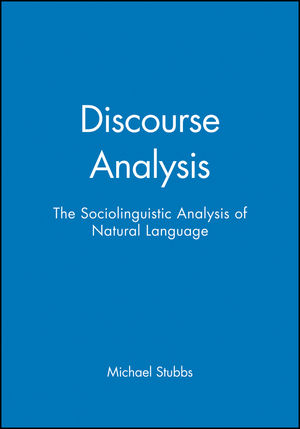Discourse Analysis: The Sociolinguistic Analysis of Natural LanguageISBN: 978-0-631-12763-5
Paperback
288 pages
January 1991, Wiley-Blackwell
 This is a Print-on-Demand title. It will be printed specifically to fill your order. Please allow an additional 10-15 days delivery time. The book is not returnable.
|
||||||
Acknowledgements.
Notational Conventions.
Part I: Introduction: .
Discourse Analysis: A Programmatic Introduction.
1. Language, action, knowledge and situation.
2. The Impossibility of Discourse Analysis.
3. Discourse Analysis and Linguistics.
4. Discourse Analysis and Sociolinguistics.
5. Terminology.
6. Idealization.
7. The State of the Art.
8. The Organization of the Book.
Part II: Three Approaches to Discourse Analysis:.
On Speaking Terms: Inspecting Conversational Data:.
9. Discourse Organization.
10. Inspecting Transcribed Data.
11. Some Observations on the Data.
12. Narrative Organisations.
13. Interactional Roles.
14. Discourse Analysis and Interaction.
15. Narrative Structure.
16. Natural Conversation.
17. Native Speaker Fluency.
18. Conclusions.
Data Appendix.
On the Same Wavelength.
19. Some initial Observations.
20. Data Collection.
21. Problems of Perception.
22. Communicative Problems in the Classroom.
23. Sociolinguistics and Language Variation.
24. Language Functions.
25. Metacommunicative Acts.
26. Monitoring Classroom talk.
27. Two Descriptive Rules of Language Use.
28. Limitations on the Analysis.
29. The Hidden Curriculum or Medium as Message.
30. Object Language and Metalanguage.
On a Different Level: Particles, Adverbs and Connectors.
31. Well...
32. Adverbs.
33. Please.
34. Tests for Speech acts.
35. Pragmatic Connectors.
36. Conclusions.
Part III: Exchange Structure:.
A Linguistic Approach to Discourse: Structures and Well-Formedness.
37. A Linguistic Approach to Discourse.
38. Predictability and well-formedness.
39. Phonotactics.
40. Grammaticality.
41. Intuitions about Discourse Sequences.
42. Predictability.
43. Predictability and Idealization.
44. Structure Controls Meaning.
45. Canonical Discourse and Idealization.
46. Analogies.
47. Conclusions.
Initiations and Responses.
48. Questions.
49. Yes-no Questions.
50. X-Questions.
51. An Initial Definition of Exchange.
52. Yes and No.
53. Observational Studies of Yes and No.
54. A-, B- and AB-events.
55. Truth and Certainty.
56. Knowledge and Beliefs.
57. Actives and Passives.
58. Conclusions.
Analysing Exchange Structure.
59. Theory, Methodology and Data.
60. Well-formedness in discourse.
61. Notational conventions.
62. Research on Exchange Structures.
63. Sinclair's Work on Discourse.
64. Basic Discourse Categories.
65. Analysis of Complete Interchange.
66. Tests for +/- initial.
67. Some Candidate Analysis.
68. Eliciting Informants' intuitions on Discourse.
69. Concluding Comments.
Part IV: Surface Cohesion and Underlying Coherence: .
Beneath the Surface of Discourse: Indirection in Speech Acts.
70. Austin: Utterances as Actions.
71. Discourse acts and Speech Acts.
72. Austin's Theory of Speech Acts.
73. Identifying Speech Acts.
74. Speech Acts and Social Roles.
75. Problems for Hearers and Readers.
76. Finding the Answer.
77. Motivating Underlying Acts.
78. Conclusions.
On the Surface of Discourse: Prefaces and Alignments.
79. The Indirection Argument.
80. Limitations on Idealized Data.
81. Formulating Turns at Talk.
82. Prefaces.
Alignmnets.
83. Acknowledge, Accept and Endorse.
84. Conclusion.
Stir Until the Plot Thickens: The Propositional Analysis of Text.
85. A Method for Investigating Narrative Structure.
86. Literacy Competence.
87. Propositions in Stories.
88. The Concepts of Plot and Summary.
89. The Semantics Analysis of Plots.
90. Propositions, Entailments and Presuppositions.
91. Existential presuppositions: or how to tell jokes.
92. Co-reference: One Cat or Two.
93. Entailments and Implications: or how to tell lies.
94. Maxims of Quantity.
95. Implicatures.
96. Summary.
97. The Sociolinguistic Analysis of Literary Language.
98. Prepositional Analysis.
99. Presuppositions.
Part V: Methodology: .
Collecting Conversational Data: Notes on Sociolinguistic Methodology.
100. The Lack of Accepted Procedures in Discourse Analysis.
101. Labov and Sociolinguistic Methodology.
102. Practical Problems.
103. How Much Data?.
104. Theoretical Biases in Recording.
105. Theoretical Biases in Transcription.
106. Field Notes.
107. Theoretical Sampling.
108. Triangulation.
109. The Problem of Perception.
110. An Illustration.
111. Conclusions.
Further Reading.
References.
Name Index.
Subject Index.



